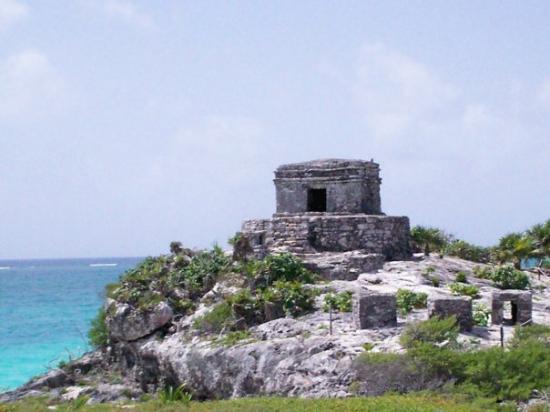TULUM, Q. Roo – Brigitte Leoni writes in reliefweb.int that Mexico’s Mayan civilisation created not only a written language and a binary mathematical system, but also a hurricane warning system that still works today.
It is housed in the clifftop Templo del Dios del Viento, or Temple of the God of the Wind, in Tulum, a Mayan site that had its heyday in the years 1200 to 1450.
The temple contains an intricate web of holes that cause an extremely loud whistling sound when early hurricane-force winds blow in from the Caribbean Sea towards Tulum.
To this day, the temple serves as a complementary warning system for the millions of tourists and local residents in the vicinity of Tulum. Fittingly, the site is 130 kilometres south of the city of Cancun, which in May hosts the 2017 Global Platform for Disaster Risk Reduction.
The Mayan early warning system has been reinforced with a more sophisticated national hurricane alert network that relies on precision weather-monitoring tools and communications technologies.
“The Tulum early warning systems says a lot about how the Maya were connected to nature and how they were able to forecast hurricanes,” said Mr. Luis Felipe Puente, Mexico’s Head of National Civil Protection.
“Today we have a national early warning system in place, involving all sectors of society, which can be mobilised and evacuated in a couple of hours, as we saw when Hurricane Patricia hit Mexico in October 2015. We mobilised the whole country in 24 hours and there was no casualties”
Mexico is struck by many hurricanes every year on both its Pacific and Atlantic shores. The Pacific season starts on 15 May and lasts until 30 November, while its Atlantic counterpart lasts from 1 June to 30 November.
An average of 23 hurricanes with winds of more than 63 kilometres per hour hit the country between May and November. Of these, 14 occur in the Pacific and nine in the Gulf of Mexico and the Caribbean. The vulnerable population has been estimated at approximately four million, due to the fact that important urban centres are located along the Mexican coastline
Last year’s Atlantic hurricane season was slightly below average in activity with 11 named storms: five tropical storms, four moderate hurricanes and two severe hurricanes. The 2016 Pacific hurricane season was the second most active on record, with 26 named storms, including 11 severe hurricanes.
Mexico has suffered many destructive hurricanes in recent years. Hurricanes Gilbert in 1988, Pauline in 1997, Wilma in 2005, and Patricia in 2015 are among the most damaging storms. The deadliest on record was a category five hurricane that struck Manzanillo on the Pacific coast, killing more than 1,800 people.
“At the time, we were unprepared and we had no real system in place to warn and evacuate people quickly. The situation is very different today. Our warnings are very efficient and issued in a couple of hours. Communities at risk are also much more prepared and know exactly what to do and where to evacuate if necessary. Hurricanes do not usually cause many casualties but economic losses caused by storms continue to remain high and need our full attention ” said Mr. Puente.
For example, while Hurricane Patricia did not claim any lives, it still damaged or destroyed some 3,500 homes and affected as many as 25,000 hectares of crops when it struck the coast of Jalisco with winds over 300 kilometres per hour. Insured losses were estimated at US$200 million.
Hurricane Wilma destroyed 6,230 homes in Yucatán and 22,750 in Quintana Roo, Tulum and Cancun’s home state.
The Global Platform, running from 22 to 26 May in Cancun, is the main multilateral forum for addressing disaster risk and is set to draw thousands of delegates. It offers a key opportunity for leaders to discuss ways to curb growing economic losses and build more resilient infrastructure, and thereby achieve the main goal of the Sendai Framework for Disaster Risk Reduction, a 15-year agreement adopted by the international community in 2015.
The Global Platform runs alongside the two-day Multi-Hazard Early Warning Conference, and will dedicate its first session to increasing availability of and access to alert systems and disaster risk information, which is another key aim of the Sendai Framework.
Source: reliefweb.int


